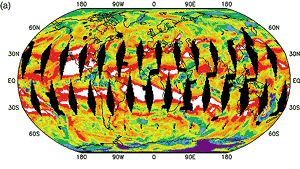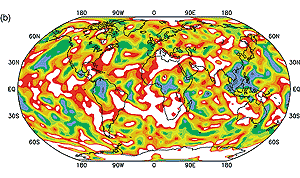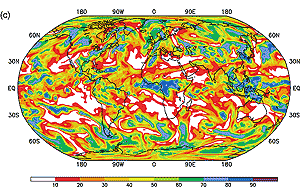7.2 Atmospheric Processes and Feedbacks
7.2.1 Physics of the Water Vapour and Cloud Feedbacks
Any increase in the amount of a greenhouse gas contained in the Earth’s
atmosphere would reduce the emission of outgoing long-wave radiation (OLR) if
the temperature of the atmosphere and surface were held fixed. The climate achieves
a new equilibrium by warming until the OLR increases enough to balance the incoming
solar radiation. Addition of greenhouse gases affects the OLR primarily because
the tropospheric temperature decreases with height. With a fixed temperature
profile, increasing the greenhouse gas content makes the higher parts of the
atmosphere more opaque to infrared radiation upwelling from below, replacing
this radiation with OLR emitted from the colder regions.
Determination of the new equilibrium is complicated by the fact that water
vapour is itself a potent greenhouse gas, and the amount and distribution of
water vapour will generally change as the climate changes. The atmospheric water
vapour content responds to changes in temperature, microphysical processes and
the atmospheric circulation. An overarching consideration is that the maximum
amount of water vapour air can hold increases rapidly with temperature, in accord
with the Clausius-Clapeyron relation. This affects all aspects of the hydrological
cycle. Unlike CO2, water vapour concentration varies substantially
in both the vertical and horizontal. An increase in water vapour reduces the
OLR only if it occurs at an altitude where the temperature is lower than the
ground temperature, and the impact grows sharply as the temperature difference
increases. If water vapour at such places increases as the climate warms, then
the additional reduction in OLR requires the new equilibrium to be warmer than
it would have been if water vapour content had remained fixed. This is referred
to as a positive water vapour feedback.
Clouds are intimately connected to the water vapour pattern, as clouds occur
in connection with high relative humidity, and cloud processes in turn affect
the moisture distribution. Clouds affect OLR in the same way as a greenhouse
gas, but their net effect on the radiation budget is complicated by the fact
that clouds also reflect incoming solar radiation. As clouds form the condensation
releases latent heat, which is a central influence in many atmospheric circulations.
The boundary layer is the turbulent, well-mixed shallow layer near the ground,
which can be regarded as being directly moistened by evaporation from the surface.
In the boundary layer, the increase in water vapour with temperature in proportion
with the Clausius-Clapeyron relation is uncontroversial. Observations (e.g.,
Wentz and Schabel, 2000) clearly show a very strong relation of total column
water vapour (precipitable water) with surface and tropospheric temperature.
Because the boundary-layer temperature is similar to that of the ground, however,
boundarylayer water vapour is not of direct significance to the water vapour
feedback. Furthermore, half of the atmospheric water vapour is below 850 mb,
so measurements of total column water have limited utility in understanding
water vapour feedback. The part of the troposphere above the boundary layer
is referred to as the “free troposphere”. Water vapour is brought
to the free troposphere by a variety of mixing and transport processes, and
water vapour feedback is determined by the aggregate effects of changes in the
transport and in the rate at which water is removed by precipitation occurring
when air parcels are cooled, usually by rising motions.
The complexity of water vapour radiative impact is reflected in the intricate
and strongly inhomogeneous patterns of the day-to-day water vapour distribution
(Figure 7.1a). The very dry and very moist regions reveal
a strong influence of the large-scale dynamical transport. Model simulations
exhibit similar patterns (Figure 7.1b), with a notable
qualitative improvement at higher resolution (Figure 7.1c).
Understanding the dominant transport processes that set up those patterns, and
how they can be affected by a modified climate, should help assess the representation
of the water vapour feedbacks in the corresponding region found in model simulations.
|



Figure 7.1: Comparison between an observational estimate from
satellite radiances and two model simulations of the complex structure
of midtropospheric water vapour distribution for the date May 5. At any
instant, water vapour is unevenly distributed in the atmosphere with very
dry areas adjacent to very moist areas. Any modification in the statistics
of those areas participates in the atmospheric feedback. The observed
small-scale structure of the strong and variable gradients (a) is not
well resolved in a simulation with a climate model of the spatial resolution
currently used for climate projections (b), but simulated with much better
fidelity in models with significantly higher resolution (c). (a): Distribution
of mean relative humidity in layer 250 to 600 mb on May 5, 1998, as retrieved
from observations on SSM/T-2 satellite (Spencer and Braswell, 1997). Missing
data are indicated by black areas and the retrieval is most reliable in
the latitude band 30°S to 30°N. (b): Relative humidity at about
400 mb for May 5 of an arbitrary year from a simulation with the GFDL
R30L14 atmospheric general circulation model used in the AMIP I simulation
(Gates et al., 1999; Lau and Nath, 1999). In small polar areas (about
5% of the globe) some relative humidities are negative (set to zero) due
to numerical spectral effects. (c): Relative humidity at 400 mb from the
ECHAM4 T106 simulation for May 5 of an arbitrary year (Roeckner et al.,
1996; Wild et al., 1998).
|
Continues on next page


